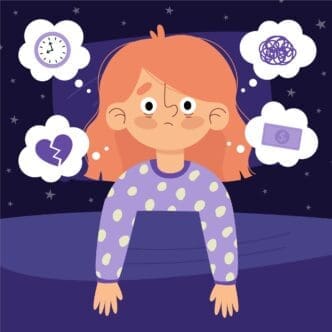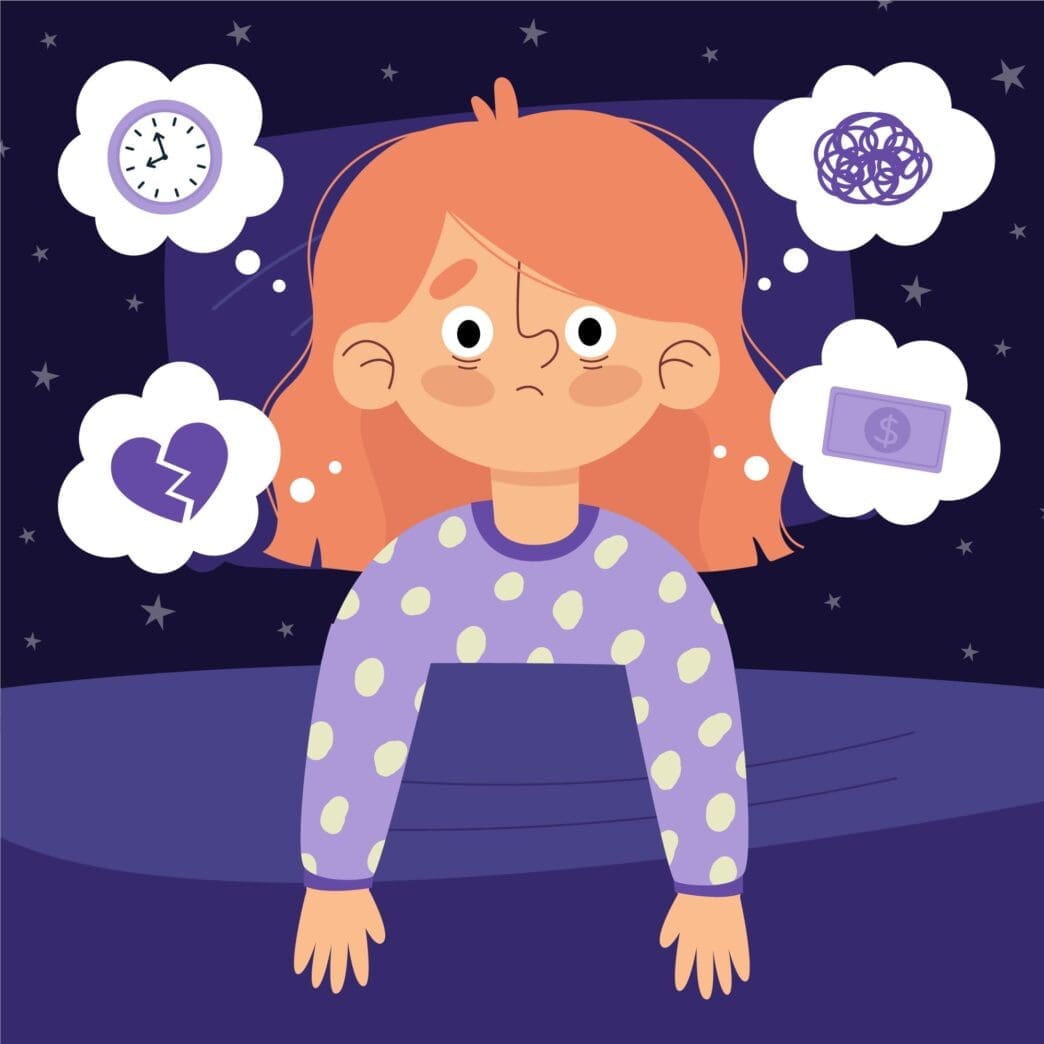For the millions who find themselves staring at the ceiling as the clock ticks past midnight, the bedroom can feel less like a sanctuary and more like a battleground. This nightly struggle, where racing thoughts and a churning stomach replace restorative rest, is a hallmark of sleep anxiety. It ensnares individuals in a vicious cycle: anxiety prevents sleep, and the lack of sleep exacerbates anxiety the next day. This phenomenon stems from a complex interplay of physiology and psychology, where a quiet environment allows worries to amplify and the body remains stuck in a state of high alert. Fortunately, by understanding these mechanisms, anyone can learn evidence-based strategies to calm their mind, relax their body, and reclaim their nights.
Why Anxiety Spikes at Night
For many, anxiety seems to have a unique power in the dark. The distractions of the day fade away, leaving you alone with your thoughts. Understanding the science behind this common experience is the first step toward managing it.
The Quiet Brain and the “Default Mode Network”
During the day, your brain is busy processing external stimuli—responding to emails, navigating traffic, and engaging in conversations. This focus keeps the more introspective parts of your brain relatively quiet. When you lie down to sleep, however, this external noise disappears.
This quietude allows a specific brain circuit, known as the Default Mode Network (DMN), to become more active. The DMN is responsible for self-referential thought, including reminiscing about the past and, crucially, worrying about the future. Without daytime tasks to occupy your mind, the DMN can easily spiral into a loop of “what-ifs” and worst-case scenarios.
The Physiology of Stress
Anxiety isn’t just in your head; it’s a full-body experience driven by your nervous system. The stress hormone, cortisol, naturally follows a daily rhythm, peaking in the morning to help you wake up and gradually declining to its lowest point at bedtime to allow for sleep.
When you experience chronic stress or anxiety, this rhythm can be disrupted. Cortisol levels may remain elevated into the evening, keeping your body in a state of physiological arousal. This activates the sympathetic nervous system—your “fight-or-flight” response—leading to physical symptoms like a rapid heart rate, shallow breathing, and muscle tension, all of which are counterproductive to sleep.
The Vicious Cycle of Sleep Anxiety
After a few difficult nights, a new fear can emerge: the fear of not sleeping itself. This is often called sleep anxiety or psychophysiological insomnia. You may start to dread bedtime, associating your bed with frustration and wakefulness rather than rest.
This anticipatory anxiety becomes a self-fulfilling prophecy. Worrying about whether you’ll get enough sleep triggers the very same stress response—elevated cortisol and an active “fight-or-flight” system—that prevents sleep in the first place. Your mind races with thoughts like, “If I don’t sleep now, I’ll be useless tomorrow,” further fueling the anxiety and pushing sleep even further away.
Creating a Sleep-Sanctuary: The Role of Environment
Your brain learns from association. To break the cycle of sleep anxiety, you must retrain your brain to associate your bedroom with calm and rest. This process, known as stimulus control, begins with optimizing your physical environment.
Optimize for Cool, Dark, and Quiet
Your body’s core temperature needs to drop slightly to initiate sleep. Keeping your bedroom cool, ideally between 60-67°F (15-19°C), facilitates this natural process. A cooler room signals to your body that it’s time to rest.
Light is the most powerful signal for your brain’s internal clock. Even small amounts of light from electronics or streetlights can suppress the production of melatonin, the hormone that regulates sleep-wake cycles. Use blackout curtains, wear a sleep mask, and cover or remove any glowing electronics from your room.
Finally, unpredictable sounds can easily startle a mind that’s already on high alert. If you can’t eliminate noise, try masking it. The consistent, gentle hum of a white noise machine, a fan, or an app can drown out disruptive sounds and provide a soothing audio backdrop for sleep.
The Bed is for Sleep and Intimacy Only
One of the core principles of Cognitive Behavioral Therapy for Insomnia (CBT-I) is strengthening the mental connection between your bed and sleep. If you work, eat, watch intense shows, or worry in bed, your brain begins to associate it with wakeful, stressful activities.
Make a firm rule to only use your bed for sleep and sex. If you find yourself lying awake for more than 20 minutes, get out of bed. Go to another dimly lit room and do something calm and relaxing, like reading a boring book or listening to soft music, until you feel sleepy again. This prevents you from tossing and turning and reinforcing the bed as a place of frustration.
Mind-Body Techniques to Unwind
When your mind is racing, you can use your body as an anchor to the present moment. Mind-body practices work by activating the parasympathetic nervous system, your body’s “rest-and-digest” system, which directly counteracts the “fight-or-flight” response.
The Power of the Breath
Your breath is a powerful, built-in tool for anxiety relief. Slow, deep, diaphragmatic breathing has been scientifically shown to lower heart rate, reduce blood pressure, and calm the nervous system. Unlike shallow chest breathing, which is associated with anxiety, deep belly breathing signals safety to your brain.
Try the 4-7-8 breathing technique: Inhale quietly through your nose for a count of four, hold your breath for a count of seven, and then exhale completely through your mouth with a whooshing sound for a count of eight. Repeat this cycle three to four times to feel a near-instant sense of calm.
Progressive Muscle Relaxation (PMR)
Anxiety often creates unconscious muscle tension throughout the body. PMR is a technique that involves systematically tensing and then releasing different muscle groups to bring awareness to this tension and let it go.
Lying in bed, start with your toes. Curl them tightly for five seconds, focusing on the feeling of tension. Then, release the tension completely and notice the difference for 10-15 seconds. Work your way up your body—calves, thighs, abdomen, arms, shoulders, and face—tensing and releasing each group. This practice not only relieves physical stress but also diverts your mind from anxious thoughts.
Mindfulness and Guided Meditation
Fighting anxious thoughts often gives them more power. Mindfulness offers an alternative: observing your thoughts and feelings without judgment. Instead of getting caught in a worry, you can learn to see it as a passing mental event, like a cloud crossing the sky.
Guided sleep meditations are an excellent entry point. Apps like Calm, Headspace, or numerous free options on YouTube provide soothing narratives that walk you through body scans or visualizations. This gives your anxious mind a gentle, calming focus, making it easier to drift off to sleep.
Cognitive Strategies: Retraining Your Anxious Brain
While environmental and physical techniques are vital, long-term relief often requires changing the thought patterns that fuel the anxiety in the first place.
Schedule “Worry Time”
Designate a specific, limited period of time—say, 15-20 minutes in the early evening—to be your official “worry time.” During this window, sit down with a pen and paper and actively engage with your anxieties. Write down what’s worrying you and brainstorm potential solutions.
The act of scheduling this gives you permission to postpone worries that arise at other times, especially at night. When a worry pops into your head as you’re trying to sleep, you can gently tell yourself, “I’ll think about that tomorrow during my scheduled worry time. Now is for rest.”
Use a “Brain Dump” Journal
Sometimes the sheer volume of thoughts, to-do lists, and unresolved issues is what keeps you awake. A “brain dump” is the simple act of externalizing these thoughts by writing them down before bed. This clears your mental workspace, reducing the feeling that you might forget something important.
You can also use a journal to shift your focus. Before closing your eyes, try writing down three specific things that went well during the day or for which you are grateful. This practice of gratitude can help counteract the brain’s natural negativity bias and promote a more positive mindset before sleep.
Challenge Unhelpful Thoughts
Sleep anxiety is fueled by catastrophic thoughts about the consequences of not sleeping. A key technique from CBT-I is learning to challenge and reframe these thoughts. When you think, “I’ll be a complete disaster tomorrow if I don’t sleep,” ask yourself if that’s 100% true.
Reframe it with a more balanced and realistic thought, such as, “I might be tired tomorrow, but I’ve managed on little sleep before. I can still get through the day. Resting in bed is still helpful, even if I’m not asleep.” This cognitive restructuring reduces the panic and pressure, making sleep more likely.
The Importance of a Wind-Down Routine
You can’t expect your brain to go from 100 to 0 in an instant. A consistent “wind-down” routine is crucial for signaling to your mind and body that the day is over and it’s time to prepare for sleep. Create a 30- to 60-minute buffer zone before your intended bedtime that is free from work, stressful conversations, and, most importantly, screens.
The blue light emitted from phones, tablets, and computers is particularly disruptive to melatonin production. Instead, fill this time with calming activities. Take a warm bath or shower—the subsequent drop in your body temperature mimics the natural drop that precedes sleep. Read a physical book, listen to a relaxing podcast or calming music, or do some gentle stretching. The consistency of the ritual is more important than the specific activities themselves.
Conclusion
Taming a mind riddled with anxiety at bedtime is not a passive wish but an active skill. It requires a conscious, compassionate, and multifaceted approach that addresses your environment, your body, and your thoughts. By creating a sleep-promoting sanctuary, practicing mind-body relaxation techniques, challenging anxious thought patterns, and establishing a consistent wind-down routine, you can systematically dismantle the cycle of sleep anxiety.
Remember that progress takes precedence over perfection. There will still be difficult nights, but with these tools, you are better equipped to navigate them. If severe anxiety and insomnia continue to disrupt your life, seeking guidance from a mental health professional or a sleep specialist is not a sign of failure, but a powerful step toward lasting well-being.












